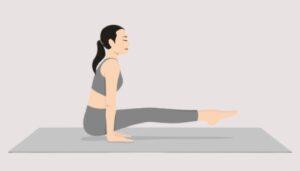Exploring Padma Mayurasana: Lotus or Bound Peacock Pose
Padma Mayurasana, a challenging yoga pose that calls for strength, balance, and flexibility, is also referred to as Lotus or Bound Peacock Pose. This pose has many physical, mental, and spiritual advantages. It blends aspects of arm balance and hip opening. We’ll examine how to perform Padma Mayurasana, its advantages, and necessary safety measures in this post.
Steps to Practice Padma Mayurasana (Bound Peacock Pose):
- Start by sitting comfortably in an easy pose, such as Sukhasana (Easy Pose), with your shoulders relaxed and your spine straight.
- Drawing your heel towards your abdomen, bend your right knee, and plant your right foot atop your left thigh. With your left leg, repeat the same motion, positioning your left foot atop your right thigh.
- Maintaining a straight spine, gradually press your knees towards the floor while in the Lotus position with both legs extended.
- With your fingers pointed towards your feet, place your palms on the ground next to your hips.
- Bring your elbows up to your abdomen by bending them slightly and leaning forward.
- Engage your core and raise your feet off the floor as you gradually move your weight forward onto your hands.
- As much as you can, extend your arms straight, but maintain your elbows slightly bent.
- To aid in balance, raise your chest and look forward while concentrating on one spot.
- As you get more comfortable, progressively extend the time you spend in the pose. Hold it for a few breaths.
- Return to a seated position after lowering your feet gradually to the floor to release.
The benefits of Padma Mayurasana (lotus or bound peacock pose):
- bolsters the shoulders, wrists, and arms.
- increases stability and core strength.
- extends the thighs and groins and opens the hips.
- stimulates the digestive system, which helps with digestion.
- improves balance, focus, and concentration.
- lessens tension and anxiety by encouraging a state of calm and relaxation.
Precautions and Contraindications of Padma Mayurasana:
Even though Padma Mayurasana has many advantages, you should proceed with cautiously, particularly if you’re a beginner or have any health issues. Here are some safety measures to think about:
- If you have injuries to your wrists, elbows, or shoulders, stay away from this position.
- Because of the pressure that the Lotus Peacock Pose puts on the abdomen, pregnant women should not perform this pose.
- Before attempting this posture, use caution or seek advice from a skilled yoga instructor if you have any hip or knee issues.
- Never force a posture on oneself; instead, always pay attention to your body. Respect your boundaries and engage in mindful practice.
- Before trying Padma Mayurasana, warm up sufficiently, paying specific attention to stretching the wrists, shoulders, hips, and core muscles.
Read More: Yoga Teacher Training in Rishikesh
In conclusion, the yoga stance known as Padma Mayurasana demands strength, balance, and flexibility. It is also very gratifying. You can reap the numerous advantages of mindfulness practice for your mental, emotional, and physical health by following the right procedures. It’s important to keep in mind that you should approach this position slowly, be mindful of your body, and open to safely exploring your edge. Growth and advancement on and off the mat depend on awareness and consistency, just like in any yoga practice.
Learn to know more about yoga poses so you can visit the best yoga school and join 200 hour yoga teacher training and aerial yoga teacher training and yin yoga teacher training




